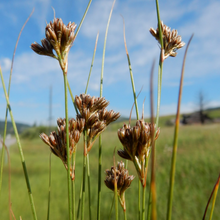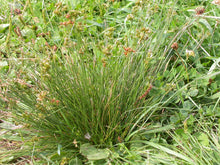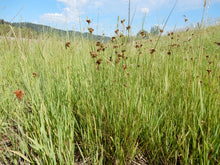Juncus tenuis
Slender rush, or path rush, forms attractive tufts of soft, bright green foliage that provide beauty and structure to the garden all year long. The leaves branch off from the base into an attractive fan-shape, with spiky flower heads positioned at the top in late summer and early fall. These flowers are relatively unnoticeable to you and I, but are attractive to pollinators and scores of beneficial insects and later become seeds that are a source of food for several species of songbirds.
- Plant type/canopy layer: evergreen, perennial, grass or grass-like plant
- Size at maturity: 6-20” tall, 12-24" wide
- Light requirements: full sun, part sun/part shade
- Moisture requirements: moist to wet soil
- Bloom time: Aug - Sept (inflorescence)
- Growth rate/ease: slow/medium growth rate, easy to grow
- Wildlife support: inflorescence attract and support bees, other insect pollinators; seeds are eaten by some upland gamebirds and songbirds; foliage is used for nest construction; overall plant attracts and supports beneficial and other pest eating insects, provides cover for foraging animals and is a caterpillar host plant and larval food source for native butterflies and moths
- Native habitat/range: found along the freshwater shorelines, swales, springs, dune hollows, openings in wet woods, marshes, damp paths, ditches, and other moist disturbed sites, from sea level to 1800m, throughout most of North America, including all 50 states. Portland Plant List - yes.
- Special features & uses: evergreen; deer resistant; groundcover (spreads by seed and rhizomes); landscape uses include erosion control, pollinator gardens, wet rock gardens, raingardens, and openings in woodland gardens
Gardening with Slender Rush: This is a highly versatile and extraordinary low-maintenance plant when planted in the right conditions; such as full to mostly sunny wetlands, raingardens or wet meadows. It will thrive in seasonally wet soil that remains moist or entirely dries out in the summer months, is excellent at controlling erosion, and is deer resistant. Though it prefers well-draining soils, it can grow in pretty much any type of soil, including having a high tolerance for compacted soils. This, plus the fact that it tends to spread laterally by rhizomes, ornamentally flanking the sides of garden paths, earns it another common name of "path rush". Due to its versatility, it can out-compete other plants and become a nice groundcover over time.
Photo Credits 1-3: "Juncus tenuis" by Matt Lavin is licensed under CC BY-SA 2.0.






